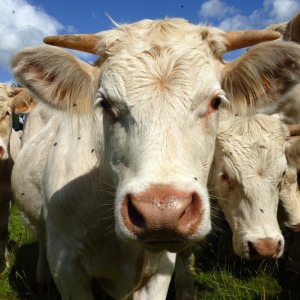
A new paper titled Distributions of emissions intensity for individual beef cattle reared on pasture-production systems details a new method, developed at the North Wyke Farm Platform, of assessing grazing livestock impacts and benefits at the level of individual animals.
The authors hope that this will enable more accurate assessment of farm greenhouse gas emissions, as well as enabling selection for cattle with lower emissions from enteric fermentation, thereby improving the sustainability of cattle production systems. In a press release, the authors acknowledge the recent FCRN report Grazed and Confused:
“We agree with the FCRN report that ruminants cannot reverse climate change, even if they are grass-fed. However, as we discussed in our 2014 article in Nature, pasture-based livestock production systems have a multifaceted role in society – the point acknowledged, but not actively addressed, by the FCRN report. At Rothamsted, not only do we aim to advance knowledge on how to minimise negative impacts of agricultural production, as exemplified by the current paper, but also on how to optimise the positive contribution grazing livestock can bring to us as part of a well-designed food supply chain.” (Michael Lee, Head of North Wyke and Professor of Sustainable Livestock Systems at Bristol Veterinary School).
Abstract
Life Cycle Assessment (LCA) of livestock production systems is often based on inventory data for farms typical of a study region. As information on individual animals is often unavailable, livestock data may already be aggregated at the time of inventory analysis, both across individual animals and across seasons. Even though various computational tools exist to consider the effect of genetic and seasonal variabilities in livestock-originated emissions intensity, the degree to which these methods can address the bias suffered by representative animal approaches is not well-understood. Using detailed on-farm data collected on the North Wyke Farm Platform (NWFP) in Devon, UK, this paper proposes a novel approach of life cycle impact assessment that complements the existing LCA methodology. Field data, such as forage quality and animal performance, were measured at high spatial and temporal resolutions and directly transferred into LCA processes. This approach has enabled derivation of emissions intensity for each individual animal and, by extension, its intra-farm distribution, providing a step towards reducing uncertainty related to agricultural production inherent in LCA studies for food. Depending on pasture management strategies, the total emissions intensity estimated by the proposed method was higher than the equivalent value recalculated using a representative animal approach by 0.9–1.7 kg CO2-eq/kg liveweight gain, or up to 10% of system-wide emissions. This finding suggests that emissions intensity values derived by the latter technique may be underestimated due to insufficient consideration given to poorly performing animals, whose emissions becomes exponentially greater as average daily gain decreases. Strategies to mitigate life-cycle environmental impacts of pasture-based beef productions systems are also discussed.
Reference
McAuliffe, G.A., Takahashi, T., Orr, R.J., Harris, P., and Lee, M.R.F. (2017). Distributions of emissions intensity for individual beef cattle reared on pasture-based production systems. Journal of Cleaner Production.
Read the full paper here.







Post a new comment »